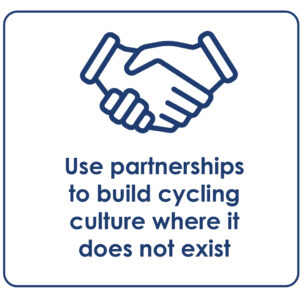 In areas where few people currently cycle, it can be difficult to implement cycling programming or gain support for new infrastructure. A partnership approach can be an effective way of reaching these communities and building cycling culture. One example of this model is where an organization with cycling expertise works with a local partner to host cycling programming. The programming is tailored to the mission and goals of the host organization, so that cycling is used to meet their clients’ needs. For example, neighbourhood rides and a bicycle loan program can increase physical activity among people with pre-diabetes, or a build-a-bike program can engage newcomer youth.
In areas where few people currently cycle, it can be difficult to implement cycling programming or gain support for new infrastructure. A partnership approach can be an effective way of reaching these communities and building cycling culture. One example of this model is where an organization with cycling expertise works with a local partner to host cycling programming. The programming is tailored to the mission and goals of the host organization, so that cycling is used to meet their clients’ needs. For example, neighbourhood rides and a bicycle loan program can increase physical activity among people with pre-diabetes, or a build-a-bike program can engage newcomer youth.
The benefits of this model flow both ways. The cycling organization gains community knowledge, presence and credibility that a stand-alone venture would lack. The host organization gains a new way to serve its clients. Through the partnership, cycling programming experience is passed from one organization to the other, with the long-term goal of having the host organization take ownership of the programming and continue it beyond the cycling organization’s involvement.
A broad approach should be used to identify potential partners. Many local organizations will have goals that could be met through cycling, such as improved health, environmental action, community building, recreation, youth empowerment, newcomer settlement, and waste reduction. These unusual partners could be community organizations, but they could also be other municipal departments.
ACTIONS
- Identify organizations in low cycling, suburban neighbourhoods which have goals related to cycling programming.
- Review the strategic plans of other municipal departments to see if cycling programming or infrastructure could help achieve any of their goals and approach them about possible collaborations.
EXAMPLES

- Scarborough Cycles is a community bike hub in a suburban district of Toronto. It began in 2015, as a partnership between four downtown organizations with cycling expertise and two local organizations without (a neighbourhood centre and a community health centre). In the second year of programming, responsibility for operations devolved to the community health centre, and they have continued to expand it in the years since.
- Toronto’s new Long-Term Waste Management Strategy (2016) includes renewed interest in fostering a culture of reduction, repair, reuse and sharing at a community level. In partnership with the Tower Renewal program, Waste Management has launched a Community Reduce & Reuse Program that includes opening bike repair hubs in community housing buildings in mostly suburban areas across the city, with the goal of diverting more bicycles from the landfill.






